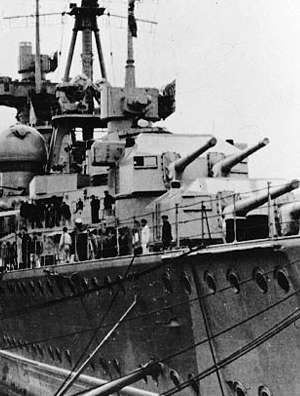20.3 cm SK C/34 naval gun
The 20.3 cm SK C/34[Note 1] was the main battery gun used on the German Admiral Hipper-class heavy cruisers.
| 20.3 cm SK C/34 naval gun | |
|---|---|
 Aft turrets of Prinz Eugen, Kiel, 1941 | |
| Type | Naval gun Coastal defence |
| Place of origin | Germany |
| Service history | |
| In service | 1939 – 1945[1] |
| Used by | Kriegsmarine |
| Wars | Second World War |
| Specifications | |
| Mass | 20.7 tonnes[2] |
| Length | 12.15 m (39.9 ft) (60 calibres)[2] |
| Shell | 122 kilograms (269 lb)[2] |
| Caliber | 20.3-centimetre (8 in)[2] |
| Elevation | -10° to +37° |
| Rate of fire | 4 – 5 rounds per minute |
| Muzzle velocity | 925 m/s (3,030 ft/s)[2] |
| Maximum firing range | 33.5 km (20.8 mi)[2] |
Description
These built-up guns consisted of a rifled tube encased within an inner and outer jacket with a horizontal sliding breech block. The breech was sealed with an 18 kg (40 lb) brass case containing 30 kg (66 lb) of smokeless powder with a 160 gram (5.6 oz) gunpowder igniter. A cloth bag containing an additional 21 kg (40 lb) of smokeless powder and 380 grams (13 oz) of gunpowder was loaded between the projectile and the brass case. Each gun could fire approximately five rounds per minute. Useful life expectancy was 510 effective full charges (EFC) per barrel.[2]
Naval service
Admiral Hipper, Blücher, and Prinz Eugen each mounted eight of these guns in 248-tonne Drh LC/34 twin turrets with a maximum elevation of 37 degrees.[2]
Coast defence guns
The four turrets intended for the incomplete cruiser Seydlitz were installed as coastal artillery in France. The turrets A (Anton) and D (Dora) at Battery Karola on the Ile de Re (4./Marine Artillerie Abteilung 282). And the turrets B (Bruno) and C (Cäsar) at Battery Seydlitz on the Ile de Croix (5./Marine Artillerie Abteilung 264).
Railway guns
Eight barrels from the incomplete cruiser were given to the army and followed rebuild to 20.3 cm K (E) railway guns.
Shell trajectory
| Range[2] | Elevation | Time of flight | Descent | Impact velocity |
|---|---|---|---|---|
| 5 km (3 miles) | 1° 54′ | 6 sec | 2° 6′ | 744 m/s (2440 ft/s) |
| 10 km (6 miles) | 4° 24′ | 14 sec | 6° 6′ | 587 m/s (1930 ft/s) |
| 15 km (9 miles) | 8° 6′ | 23 sec | 12° 48′ | 463 m/s (1520 ft/s) |
| 20 km (12 miles) | 13° 18′ | 36 sec | 23° 36′ | 382 m/s (1250 ft/s) |
| 25 km (15 miles) | 20° 18′ | 51 sec | 36° 48′ | 353 m/s (1160 ft/s) |
| 30 km (18 miles) | 29° 6′ | 69 sec | 48° 48′ | 363 m/s (1190 ft/s) |
See also
Weapons of comparable role, performance and era
- 203mm/50 Modèle 1924 gun French equivalent
- 203 mm /53 Italian naval gun Italian equivalent
- 20 cm/50 3rd Year Type naval gun Japanese equivalent
- BL 8 inch Mk VIII naval gun UK equivalent
- 8"/55 caliber gun US equivalent
Footnotes
- Notes
- SK – Schnelladekanone (quick loading cannon); C – Construktionsjahr (year of design)
- Citations
- Whitley 1995 p.57
- Campbell 1985 pp.235–237
References
- Campbell, John (1985). Naval Weapons of World War Two. Naval Institute Press. ISBN 0-87021-459-4.
- Whitley, M.J. (1995). Cruisers of World War Two. Brockhampton Press. ISBN 1-86019-874-0.
External links
| Wikimedia Commons has media related to 20.3 cm SK C/34 naval gun. |
- Tony DiGiulian, German 20.3 cm/60 (8") SK C/34